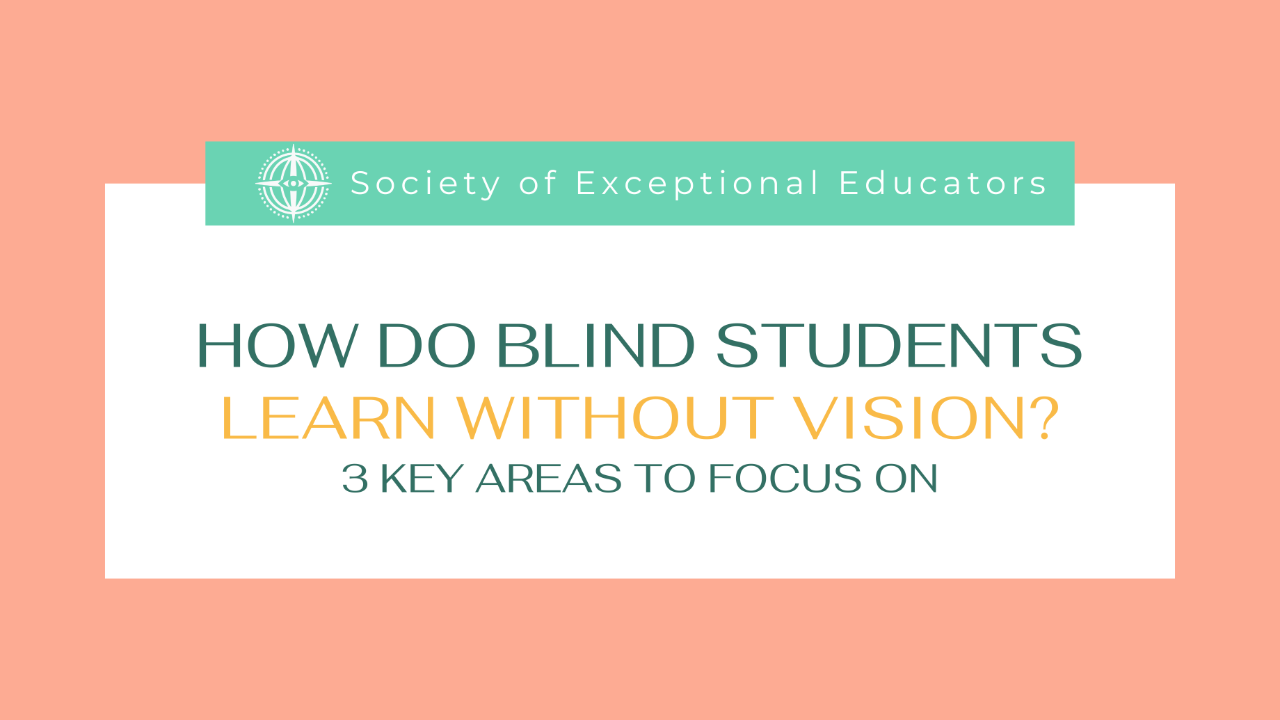How Blind Students Learn: 3 Practical Strategies Every Teacher Can Use
Mar 11, 2025
As an Orientation and Mobility Specialist working in schools for over 17 years, I’ve often been asked, “How do blind students learn without vision?” It’s a fair question—and one I love answering.
Many of us grew up assuming learning was primarily visual. After all, 90% of the information we gather is through sight. But what happens when students don’t have reliable access to visual information? How can we, as educators, make sure they’re fully included in the classroom experience?
In this blog post, we’ll explore how blind and visually impaired students learn, break down three essential strategies you can implement today, and provide actionable tips to help you create an inclusive classroom environment.
Whether you're a general education teacher, special education professional, paraprofessional, or an Orientation and Mobility Specialist, you'll find valuable insights here to support your students’ learning and independence.
👉 Free Resource Alert! Grab the 5 Keys to Supporting Students with Visual Impairments Cheatsheet here.
Understanding How Blind Students Learn: Part-to-Whole vs. Whole-to-Part
Here’s a concept that changed the way I teach: Students with visual impairments often learn part-to-whole, whereas sighted learners typically absorb information whole-to-part.
Let me give you a concrete example. Imagine a typical child watching their mom make a peanut butter and jelly sandwich. From infancy, they’ve seen it happen countless times without formal instruction—where the bread comes from, how the knife spreads peanut butter, even that there’s smooth versus crunchy options. This is incidental learning, and it’s largely visual.
But for students with visual impairments, that same process is completely different. Without seeing it unfold, they don’t pick up on those incidental details. They might hear sounds or feel textures but miss key concepts like:
- Bread comes pre-sliced
- Peanut butter needs to be spread
- There are choices between brands and textures
This is why part-to-whole learning is so essential. We may need to explicitly teach what a jar feels like, how a knife works, and how to spread peanut butter before introducing the concept of making a sandwich as a whole task.
🔑 Educator Takeaway: Don’t assume prior knowledge. Be prepared to fill in concept gaps with explicit, multisensory instruction.
For more on bridging concept gaps, check out 3 Impactful Classroom Modifications for Students with Visual Impairments.
#1 Prioritize Educational Accessibility in Every Lesson
One of the biggest barriers for blind students isn’t a lack of intelligence or willingness—it’s inaccessibility.
As educators, we’re often juggling a thousand tasks. I’ve been there, standing in a classroom realizing the Braille materials didn’t arrive in time, or the student with a visual impairment has no way to participate in the movement video the rest of the class is enjoying.
Quick Wins for Accessibility
- Audit your classroom: Are there posters or visual aids your blind student can’t access? Provide tactile graphics or digital versions with screen reader compatibility.
- Think purpose over vehicle: Ask yourself, “What’s the goal of this activity?” If it’s matching shapes, maybe tactile cutouts work better than printed worksheets.
- Establish predictable routines: Consistency helps students anticipate what’s next and reduces anxiety. For instance, always starting GoNoodle with the same video gives them a chance to learn it and participate fully.
#2 Focus on Orientation and Mobility Skills Daily
I can’t stress this enough: If students can’t get where they need to go, they can’t learn.
Mobility is foundational. Imagine needing water but not being able to find the fountain independently. Or missing your favorite center activity because you can’t navigate there without help. These small barriers add up to missed learning opportunities.
Strategies to Support Mobility
- Collaborate with your O&M Specialist: Ask them to model how they teach routes, then reinforce those skills in your classroom.
- Give consistent verbal directions: Instead of “over there,” try “The art station is three steps to your right.”
- Encourage exploration: Safely allow students time to explore the classroom layout, materials, and routes on their own terms.
#3 Reinforce Skills Through Generalization and Team Collaboration
Students with visual impairments need repetition and generalization across environments to truly master new skills. That means we can’t just teach a concept once and expect it to stick.
Practical Tips
- Role release: Once your student demonstrates a skill 50-60% independently, encourage other staff or family members to practice it with them.
- Document progress: Take videos or pictures (with consent) and share them with the team to ensure consistent reinforcement.
- Schedule team check-ins: Regular meetings with the student’s team (TVI, O&M Specialist, parents, paraprofessionals) make sure everyone’s on the same page.
Ready to Support Your Students? Here’s Your Next Step!
Teaching students with visual impairments doesn’t require reinventing the wheel—it requires intentional strategies, collaboration, and a heart for inclusion. You’re already here, learning how to be better. That’s huge.
👉 Download your FREE PDF Cheatsheet: 5 Keys Every Educator Should Know to Support Students with Visual Impairments. It’s packed with quick tips and insights you can apply today.
Plus, when you join the Free Members to the Society of Exceptional Educators here, you’ll get ongoing support, resources, and training without feeling overwhelmed.
Final Thoughts
As an Orientation and Mobility Specialist, I know firsthand the challenges (and joys!) of supporting blind and visually impaired students. I hope these strategies spark ideas and remind you—you’re not alone in this work. Every small change you make can have a huge impact on a student’s life.
Topics: How blind students learn, part-to-whole learning, visual impairments in education, teaching blind students, orientation and mobility strategies, inclusive classroom tips, special education resources, Cassie Maloney, Society of Exceptional Educators, FAPE, adapting classrooms for visually impaired students, teaching techniques for VI learners

